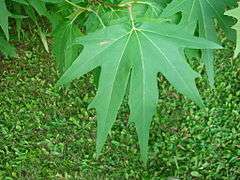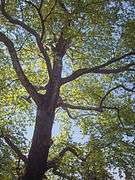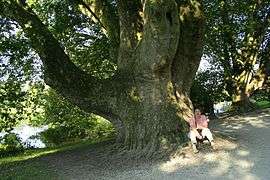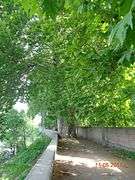Platanus orientalis
Platanus orientalis, the Old World sycamore, or Oriental plane,[2] is a large, deciduous tree of the Platanaceae family, growing to 30 m (98 ft) or more,[3] and known for its longevity and spreading crown. In fall its deep green leaves may change to blood red, amber, and yellow.
| Oriental plane | |
|---|---|
| Scientific classification | |
| Kingdom: | Plantae |
| Clade: | Tracheophytes |
| Clade: | Angiosperms |
| Clade: | Eudicots |
| Order: | Proteales |
| Family: | Platanaceae |
| Genus: | Platanus |
| Species: | P. orientalis |
| Binomial name | |
| Platanus orientalis | |
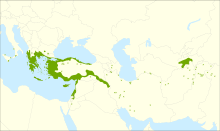 | |
| Distribution map | |
Etymology
The species' name means 'eastern'. (In comparison, the 'western' plane (or American sycamore) is named Platanus occidentalis). The eastern plane's original distribution was eastward from the Balkans. The tree was called platane in ancient Greek history and literature and by related names in continental Europe. Equally well known in Asia and from Anatolia to Kashmir and usually called chinar or chenar. In the Kashmir Valley region, the native Kashmiri word for the tree is booune.
Range
The native range is Eurasia from the Balkans to at least as far east as Iran. Some accounts extend its native range to Iberia in the west, and to the Himalayas in the east. As it has been known in cultivation from early times in much of this region it can be difficult to determine if it is truly indigenous in peripheral areas.
Description
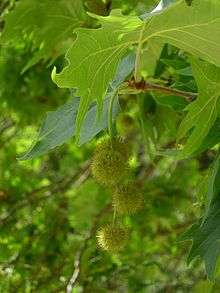
The oriental plane is found naturally in riverine settings, together with such trees as alder, willow and poplar. However, it is quite capable of survival and success in dry soils once it is established.
Like other plane trees, its leaves are borne alternately on the stem, deeply lobed, and palmate or maple-like. It usually has flaking bark, occasionally not flaking and becoming thick and rugged. Flowers and fruit are round and burr-like, borne in clusters of between 2 and 6 on a stem. Considerable variation exists among trees in the wild, and this may be complicated by crossbreeding with planted London planes (Platanus x acerifolia), the hybrid of P. orientalis with the American sycamore (Platanus occidentalis).
Cultivation
The tree is capable of being grown in most temperate latitudes, though it benefits greatly from warm summers. As a very large and wide tree with broad, thick leaves that tend to orient horizontally, it is especially prized for the shade and coolness it provides during the hot season.
It grows best in rich soil in a sunny location[4] and can survive drought well. Although young plants appreciate regular watering.
Other uses
The leaves and bark have been used medicinally. A fabric dye has been made from the twigs and roots. The timber, often called lacewood, is figured and valuable for indoor furniture. The leaves are also often used by artists for leaf carving.[5][6]
Cultural history
From earliest days, P. orientalis has been an important tree in Persian gardens, which are built around water and shade. There it is known as the chenar.
Greece
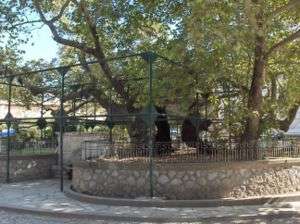
The Tree of Hippocrates, under which Hippocrates — the "Father of Medicine" — taught at Kos, is reputed to have been an oriental plane. A 500-year-old tree presently there may be on the same site and may have been planted from a succession of cuttings from the original. The Athenian Academy, outside Athens, featured a sacred grove of planes where the students listened to the masters and where among others the Peripatetics practiced philosophy.
Pliny's Natural History[7] records the westward progress of the plane "introduced among us from a foreign clime for nothing but its shade", planted first at the tomb of Diomedes on the island of Tremiti, then imported to Greek Sicily by Dionysius the Elder (c. 432-367 BC), tyrant of Syracuse. He had plane-trees conveyed to the city of Rhegium (Reggio di Calabria), where they were looked upon as the great marvel of his palace, according to Pliny's sources. From there it spread by the first century CE as far as the lands of the Morini in Belgic Gaul. Regardless of why it may have been introduced, the tree had medicinal uses from early times. Pliny[8] details 25 remedies using preparation from the bark, leaves and excrescences of plane. Pliny prescribes it for burns, bites, stings, frostbite and infections.
Pliny goes on to describe some legendary plane-trees.[9] There was one on the grounds of the Athenian Academy, he says, that had roots 50 feet (15 m) long. Licinius Mucianus held a banquet for 19 in a hollow plane-tree of Lycia, and the emperor Caligula another for 15 plus servants in a tree house (nest) built in the branches of a plane-tree at Velletri.
Most small villages in Greece have one or more very old planes in their central square, where the village water spring used to be (water springs are nowadays replaced by water taps from the same spring captured). Many of them are set in cavities, which are often playing and meeting points for children and teenagers, or are cared for, sometimes even illuminated, as tourist attractions.
Kashmir
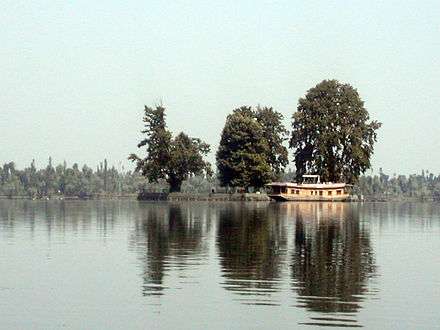
Chinar is continued to be a major garden and landscape tree and dominates many historic gardens, It is a living heritage of Kashmir. It is seen as a symbol for the region, and a part of its soul. It is a majestic tree that can be found throughout the landscape of the valley, hillsides and cities, now generally called booune in local Kashmiri and chinar by Urdu speakers.[10] For example, a famous landmark in Srinagar is an island on Dal Lake where four chinar trees stand, named Char Chinar.The tree known for its elegance and exuberance has remained an attraction for artists and litterateurs.
Kashmir Valley is the home of world’s oldest chinar tree (627 years old) which is located in village Chattergam of Budgam district, Kashmir,it is believed to be planted in 1374 A.D by an Islamic mystic Syed Abul Qaim Hamadani (RA) who accompanied Mir Sayyid Ali Hamadani (RA) from Iran to Kashmir, which has a girth of 31.85 m at ground level and 14.78 m at breast height.[11].[12][13]
Chinar trees are being felled rapidly in Kashmir,[14] although a recent ban has been enacted to curb cutting.[15] Chinar trees[16] are now required to be registered and are considered State Property. Registered Chinars are painted white at their base. Increased awareness means most old Chinars are protected and looked after; however, some new Chinars must be cut as their growth can cause damage to roads and houses. Chinars are considered as the symbols of the Persian influence on the heritage of Kashmir.
United Kingdom
In 2011 a specimen planted by Capability Brown at Corsham Court in Wiltshire was identified in 2011 by The Tree Register of the British Isles as the tree with the greatest known spread in the United Kingdom.[17]
An example dating to at least 1762 is one of Kew Gardens' thirteen 'Heritage Trees'.[18]
Cultural references
A plane tree is the main theme in the aria Ombra mai fu composed by George Frideric Handel, in which the main character, Xerxes I of Persia, admires the shade of a plane tree. It is also the State tree of Indian state Jammu and Kashmir.[19]
During the 2010 Commonwealth Games opening ceremony, held in India, the aerostat used took the shape of a chinar tree under the 'tree of knowledge' segment of the ceremony. This was followed by representation of different seasons through image projections and different dance styles being performed by hundreds of cultural dancers from all across India.
Gallery
References
- World Conservation Monitoring Centre (1998). "Platanus orientalis". IUCN Red List of Threatened Species. 1998. Retrieved 10 May 2006.CS1 maint: ref=harv (link)
- "BSBI List 2007". Botanical Society of Britain and Ireland. Archived from the original (xls) on 2014-10-23. Retrieved 2014-10-17.
- RHS A-Z encyclopedia of garden plants. United Kingdom: Dorling Kindersley. 2008. p. 1136. ISBN 978-1405332965.
- "Platanus orientalis Oriental Plane, Oriental planetree PFAF Plant Database". pfaf.org. Retrieved 2020-01-27.
- Dina Spector (August 18, 2011). "Incredible Artwork Hand-Carved From Leaves". Business Insider. Retrieved May 30, 2016.
- David Moye (August 16, 2011). "Leaf Carving Artists In China Branching Out Into Pop Culture". Huffington Post. Retrieved May 30, 2016.
- XII.3.
- XXIV.29
- XII.5
- "[9]". Official Website of Jammu & Kashmir Tourism. May 19, 2020.
- Ganaie, Shabeer A.; Bhat, Arshad (2019-05-15). "Macro-level transition and agricultural sustainability in Kashmir". AGRICULTURE UPDATE. 14 (2): 174–182. doi:10.15740/has/au/14.2/174-182. ISSN 0973-1520.
- Rajesh Bhat (2007-12-24). "627-year-old living legend found in Kashmir". Merinews.com.
- Mooney-Singh, Chris (2014). "Pantun of the Chinar Grove (Sri Nagar, Kashmir)". Manoa. 26 (1): 68–69. doi:10.1353/man.2014.0024. ISSN 1527-943X.
- "Climate". Official Website of Anantag District. Archived from the original on 2009-03-13.
- "Ban on cutting Chinar trees in Kashmir". The Times of India. 5 March 2009.
- "Where Do Chinar Trees Grow In India". India Gardening. 2019-10-25. Retrieved 2020-01-27.
- "Corsham Court Oriental plane 'most spreading tree in UK'". BBC News. 2011-07-06. Retrieved 2011-07-06.
- "Oriental plane in the Royal Botanic Gardens, Kew, England, United Kingdom". monumentaltrees.com. Retrieved 7 September 2018.
- "State Symbol of Jammu And Kashmir". www.mapped.com. Retrieved 15 December 2018.
External links
- Plants for a Future
- Platanus orientalis
- Chenarestan
- Platanus orientalis - information, genetic conservation units and related resources. European Forest Genetic Resources Programme (EUFORGEN)

